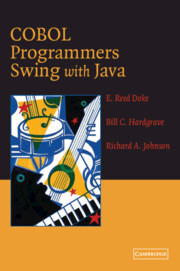Book contents
- Frontmatter
- Contents
- Preface
- Introduction
- Chapter 1 Why You Should Learn Java
- Chapter 2 An Introduction to Object-Oriented Programming
- Chapter 3 Java Structure
- Chapter 4 Defining Data
- Chapter 5 Computation
- Chapter 6 Decision Making
- Chapter 7 Loops
- Chapter 8 Arrays
- Chapter 9 Data Access
- Chapter 10 Graphical User Interfaces
- Chapter 11 Object-Oriented Development Issues
- Glossary
- Index
Chapter 2 - An Introduction to Object-Oriented Programming
Published online by Cambridge University Press: 26 August 2009
- Frontmatter
- Contents
- Preface
- Introduction
- Chapter 1 Why You Should Learn Java
- Chapter 2 An Introduction to Object-Oriented Programming
- Chapter 3 Java Structure
- Chapter 4 Defining Data
- Chapter 5 Computation
- Chapter 6 Decision Making
- Chapter 7 Loops
- Chapter 8 Arrays
- Chapter 9 Data Access
- Chapter 10 Graphical User Interfaces
- Chapter 11 Object-Oriented Development Issues
- Glossary
- Index
Summary
OBJECTIVES
In this chapter you will study:
The history of OO;
What it means to be object-oriented; and
Key object-oriented concepts.
This chapter is devoted to the introduction of the key concepts essential to your understanding of the OO paradigm in general and writing OO code in particular. This chapter describes the primary OO concepts: objects, classes, inheritance, encapsulation, polymorphism, and dynamic binding. A basic understanding of these ideas will enable you to begin writing Java programs and developing object-oriented systems.
Several examples are used throughout the chapter to illustrate the concepts. In most cases, the examples are based on everyday things with which you are already familiar. A case study (The Community National Bank Case) is introduced at the beginning of the chapter and will be used to illustrate OO concepts. The case study will continue to be used throughout the remainder of the book.
NOTES
OO development is a different way of thinking about the development of systems—it is not simply a programming technique.
Although programming languages were the first to utilize the ideas of OO, the concepts of OO are prevalent throughout all phases of development—analysis, design, and programming.
It is very important that you understand the basics of OO before attempting to write a Java program.
- Type
- Chapter
- Information
- COBOL Programmers Swing with Java , pp. 21 - 40Publisher: Cambridge University PressPrint publication year: 2004



